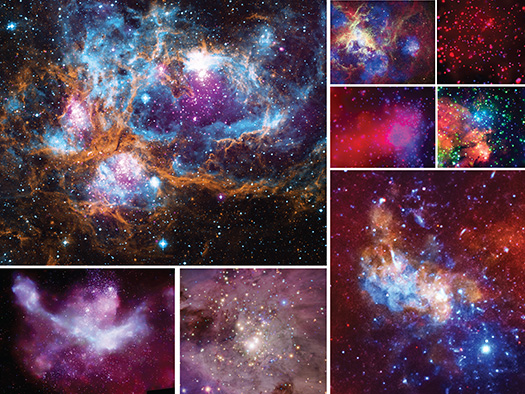A Pair of Merging Galaxies Ignite Black Holes on a Collision Course
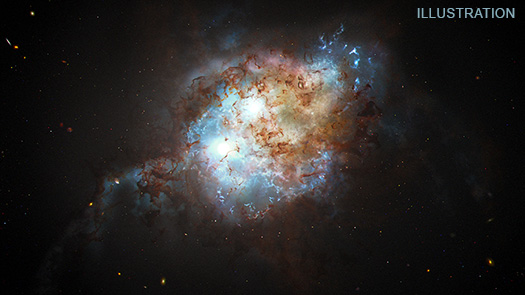
Artist's Illustration of Dual Quasar J0749+2255
Artwork Credit: NASA, ESA, Joseph Olmsted (STScI)
Science Credit: NASA, ESA, Yu-Ching Chen (UIUC), Hsiang-Chih Hwang (IAS), Nadia Zakamska (JHU), Yue Shen (UIUC)
Quasars are among the universe's brightest fireworks. Scattered all across the sky, they blaze with the opulence of over 100 billion stars. And, like a brilliant July 4th aerial flare, they are dazzling for a relatively brief time — on cosmic timescales. That's because they're powered by voracious supermassive black holes gobbling up a lot of gas and dust that gets heated to high temperatures. But the quasar food buffet lasts only so long.
This fleeting characteristic of quasars helped astronomers find two quasars on a collision course with each other. They are embedded inside a pair of galaxies that smashed into each other 10 billion years ago. It's rare to find such a dynamic duo in the far universe. The detection yields clues as to how unsettled the cosmos was long ago, when galaxies more frequently collided and black holes were engorged with flotsam and jetsam from the close encounters.
Chandra Determines What Makes a Galaxy's Wind Blow

NGC 253
Credit: X-ray: NASA/CXC/The Ohio State Univ/S. Lopez et al.; H-alpha and Optical: NSF/NOIRLab/AURA/KPNO/CTIO; Infrared: NASA/JPL-Caltech/Spitzer/D. Dale et al; Full Field Optical: ESO/La Silla Observatory.
On Earth, wind can transport particles of dust and debris across the planet, with sand from the Sahara ending up in the Caribbean or volcanic ash from Iceland being deposited in Greenland. Wind can also have a big impact on the ecology and environment of a galaxy, just like on Earth, but on much larger and more dramatic scales.
A new study using NASA's Chandra X-ray Observatory shows the effects of powerful winds launched from the center of a nearby galaxy, NGC 253, located 11.4 million light-years from Earth. This galactic wind is composed of gas with temperatures of millions of degrees that glows in X-rays. An amount of hot gas equivalent to about two million Earth masses blows away from the galaxy's center every year.
NGC 253 is a spiral galaxy, making it similar to our Milky Way. However, stars are forming in NGC 253 about two to three times more quickly than in our home galaxy. Some of these young stars are massive and generate a wind by ferociously blowing gas from their surfaces. Even more powerful winds are unleashed when, later in their relatively short lives, these stars explode as supernovae, and hurl waves of material out into space.
A Rocking Space Duet Featuring an Explosive Riff
R Aquarii, All Wavelengths
Your browser does not support the video tag.
Credit: X-ray: NASA/CXC/SAO/R. Montez et al.; Optical: Data: NASA/ESA/STScI, Enhanced processing by Judy Schmidt (CC BY-NC-SA). X-ray/Optical composite processing by CXC/N. Wolk & K.Arcand; Sonification: NASA/CXC/SAO/K.Arcand, SYSTEM Sounds (M. Russo, A. Santaguida)
The system called R Aquarii unfolds dramatically through the eyes of NASA’s Chandra X-ray Observatory (purple) and Hubble Space Telescope (red and blue). The spectacular structures outlined in the Hubble data are old notes, or in other words, evidence from outbursts generated by a pair of stars buried at the center of the image. X-rays from Chandra reveal how a jet from one of these stars — a cool stellar ember known as a white dwarf — is banging into the material surrounding it. This high-powered flow creates shock waves, similar to sonic booms from planes that move faster than the speed of sound. The other player with the white dwarf in this interstellar duet is a red giant star. As they orbit each other, the white dwarf pulls material from the red giant onto its surface. Over time, enough of this material accumulates and triggers an explosion. Astronomers have seen such outbursts over recent decades and this dynamic chorus will likely go on for millennia to come.
Powerful Yet Lonely: The Distant Quasar Left Alone in its Group
We are happy to welcome Valentina Missaglia as a guest blogger. She is the first author of the paper that is the subject of our latest press release. She is currently a postdoctoral researcher at the Institute of Astrophysics — FORTH in Heraklion (Crete) in the SMILE (“Search for Milli-LEnses”) group, recently funded by an ERC grant, that aims at investigating the nature of dark matter through observations of gravitational lenses on milli-arcsecond scales. Valentina earned her Ph.D. from the University of Turin (Italy) and her research focuses on radio and X-ray emission from radio-loud active galactic nuclei (which contain supermassive black holes that are rapidly pulling in material, producing intense radio waves) and how these sources interact with the surrounding medium. Before starting her Ph.D. in 2019, Valentina was a visiting student at the Center of Astrophysics | Harvard & Smithsonian, where she collaborated with Dr. Ralph Kraft on observations of galaxy clusters performed with NASA’s Chandra X-ray Observatory.
Looking at the night sky with the naked eye, we can only see an infinitesimal part of what the Universe contains, and the largest part cannot even be “seen”. Radio wavelengths have gifted us some of the most fascinating astronomical sources: radio-loud active galactic nuclei in the centers of galaxies, which can produce jets that extend way farther out from the optical galaxy itself.
The most powerful radio sources in the northern hemisphere are listed in a well- studied catalog, the Third Cambridge Catalog (3C), which contains the source we investigated with multiwavelength observations: 3C 297. This source appeared very intriguing in observations performed with Chandra in 2016. Therefore, we requested more time to better investigate features that we uncovered thanks to this first short observation, such as hot, X-ray emitting gas around our source.
Unlocking the Mysteries of the Historic Tycho Supernova
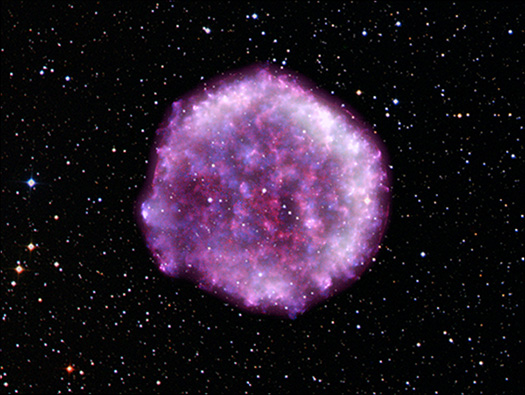
Tycho's Supernova Remnant
Credit: X-ray (IXPE: NASA/ASI/MSFC/INAF/R. Ferrazzoli, et al.), (Chandra: NASA/CXC/RIKEN & GSFC/T. Sato et al.) Optical: DSS, Image processing: NASA/CXC/SAO/K. Arcand, L. Frattare & N. Wolk
This image provides a new look at the Tycho supernova remnant, named for Danish astronomer Tycho Brahe who noticed the bright glow of this new “star” in the constellation Cassiopeia more than 450 years ago. Astronomers used NASA’S Imaging X-ray Polarimetry Explorer (IXPE) to study polarized light from Tycho, the debris from an exploded star, as described in IXPE’s latest press release. IXPE revealed, for the first time, the geometry of the magnetic fields close to the supernova’s blast wave, which is still propagating from the initial explosion and forms a boundary around the ejected material. Understanding the magnetic field geometry allows scientists to further investigate how particles are accelerated there.
In this composite image, data from IXPE (dark purple and white) have been combined with those from NASA’s Chandra X-ray Observatory (red and blue), which were overlaid with the stars in the field of view seen by the Digitized Sky Survey.
Chandra's Indirect Glance into the Early Universe: Merging Dwarf Galaxies and their AGN
We are pleased to welcome Marko Mićić as a guest blogger. Marko led the study that is the subject of our latest press release [link to PR]. He graduated from the University of Belgrade, Serbia, with a degree in Astronomy and Astrophysics, in 2018. The same year he started a Ph.D. at the University of Alabama, and has been working under Dr. Jimmy Irwin's supervision since then. His research interests include evolution of low-mass galaxies, AGN content of low-mass galaxies, intermediate-mass black holes and gravitational lenses.
Galaxies are made up of billions of stars, interstellar gas and dust, and large amounts of dark matter. Every (or almost every) galaxy is expected to host a supermassive black hole in its center. Galaxies and their central black holes grow and evolve together predominantly through mergers; smaller objects merge to create larger ones over time. However, the earliest stages of galaxy evolution involving the mergers of the first galaxies are poorly understood. It is unclear how the first mergers affected the morphology of ancient galaxies and their star formation. We also do not know how massive the first black holes were that inhabited the first galaxies, nor how the first mergers influenced their ability to accrete – pull in – material.
It is challenging to answer these important questions because the first mergers are too distant and faint to be directly observed. One way to overcome this issue is to look for local analogs. In other words, we need to find pairs of small, dwarf galaxies that have had very quiet lives, with almost no mergers, that have only recently met and started interacting. Such galaxies have experienced little to no evolution so they are analogs of distant, ancient galaxies, and observations of their mergers would represent the local case study that illustrates the hierarchical growth of structures in the early Universe. Their central black holes are also expected not to have grown much and preserve information about primordial seeds, potentially holding the key to resolving the outstanding problem of the origin of supermassive black holes.
Untangling a Knot of Galaxy Clusters
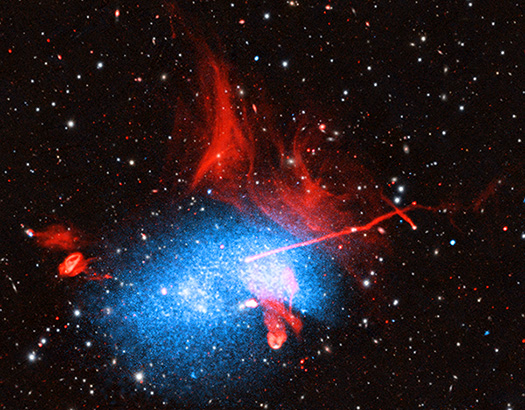
Abell 2256
Credit: X-ray: Chandra: NASA/CXC/Univ. of Bologna/K. Rajpurohit et al.; XMM-Newton: ESA/XMM-Newton/Univ. of Bologna/K. Rajpurohit et al. Radio: LOFAR: LOFAR/ASTRON; GMRT: NCRA/TIFR/GMRT; VLA: NSF/NRAO/VLA; Optical/IR: Pan-STARRS
Astronomers have captured a spectacular, ongoing collision between at least three galaxy clusters. Data from NASA’s Chandra X-ray Observatory, ESA’s (European Space Agency’s) XMM-Newton, and a trio of radio telescopes is helping astronomers sort out what is happening in this jumbled scene. Collisions and mergers like this are the main way that galaxy clusters can grow into the gigantic cosmic edifices seen today. These also act as the largest particle accelerators in the universe.
The giant galaxy cluster forming from this collision is Abell 2256, located 780 million light-years from Earth. This composite image of Abell 2256 combines X-rays from Chandra and XMM in blue with radio data collected by the Giant Metrewave Radio Telescope (GMRT), the Low Frequency Array (LOFAR), and the Karl G. Jansky Very Large Array (VLA) all in red, plus optical and infrared data from Pan-STARRs in white and pale yellow.
Astronomers Dig Out Buried Black Holes With NASA's Chandra
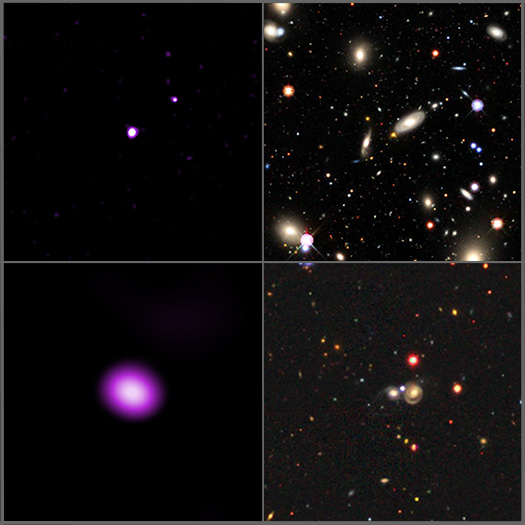
SDSS J011522.18+001518.5 and SDSS J155627.74+241758.9
Credit: X-ray: NASA/CXC/SAO/D. Kim et al.; Optical/IR: Legacy Surveys/D. Lang (Perimeter Institute)
This panel of images represents a survey that used data from NASA’s Chandra X-ray Observatory to uncover hundreds of previously “hidden” black holes. This result helps astronomers conduct a more accurate census of supermassive black holes that exist in the centers of most large galaxies, as reported in our latest press release.
This graphic shows two of the galaxies from the new study, with Chandra X-ray data in purple and optical data from the Sloan Digital Sky Survey (SDSS) in red, green and blue. These black holes were found in galaxies that are dim in optical light, but bright in X-rays. Astronomers have dubbed these “XBONGs” (for X-ray bright, optically normal galaxies). While scientists have been aware of XBONGs for several decades, an explanation for their unusual properties has been unclear.
The Enduring Stellar Lifecycle in 30 Doradus

30 Doradus
Credit: X-ray: NASA/CXC/Penn State Univ./L. Townsley et al.; IR: NASA/ESA/CSA/STScI/JWST ERO Production Team
The largest and brightest region of star formation in the Local Group of galaxies, including the Milky Way, is called 30 Doradus (or, informally, the Tarantula Nebula). Located in the Large Magellanic Cloud, a small neighbor galaxy to the Milky Way, 30 Doradus has long been studied by astronomers who want to better understand how stars like the Sun are born and evolve.
NASA’s Chandra X-ray Observatory has frequently looked at 30 Doradus over the lifetime of the mission, often under the direction of Dr. Leisa Townsley who passed away in the summer of 2022. These data will continue to be collected and analyzed, providing opportunities for scientists both now and in the future to learn more about star formation and its related processes.
This new composite image combines the X-ray data from Chandra observations of 30 Doradus with an infrared image from NASA’s James Webb Space Telescope that was released in the fall of 2022. The X-rays (royal blue and purple) reveal gas that has been heated to millions of degrees by shock waves — similar to sonic booms from airplanes — generated by the winds from massive stars. The Chandra data also identify the remains of supernova explosions, which will ultimately send important elements such as oxygen and carbon into space where they will become part of the next generation of stars.
The Enduring and Engaging Legacy of Leisa Townsley
When Dr. Leisa Townsley passed away this summer, the scientific community lost a brilliant researcher, teacher, and mentor. She was all of those things, but we wanted to feature some of the pivotal and critical ways that she helped the Chandra X-ray Observatory, specifically our Communications and Public Engagement work.
Chandra was launched into space in 1999 and with the beginning of its successful operations, a new era in high-energy astrophysics was born. For certain deep space objects that emitted enough X-ray photons, Chandra brought, for the first time, the ability to create richly detailed, high-resolution images. These X-ray images, however, were different in many ways from the images of its previously-launched sister Great Observatory, the Hubble Space Telescope.
Establishing a visual identity for Chandra, both on its own and in collaboration with other telescopes that study different kinds of light, including Hubble, was no small challenge. Our Chandra group was responsible for finding the best way to show X-ray data, which often looks completely different from optical data. Would traditional techniques used for visible light data be suitable to process X-ray data? Would new processes and tactics need to be developed to make X-ray data more accessible, easier to understand and process?



